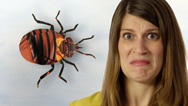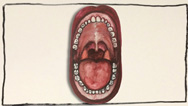What is the Black Plague?
- By Anna Rothschild
- Posted 08.27.15
- NOVA
Plague sounds like a medieval disease, but there are a few cases in the US every year. So, what is plague? And should you be worried? Find out in this episode of Gross Science.
Transcript
What is the Black Plague?
Posted: August 27, 2015
Hey everyone!
So, you might have seen on the news recently that a couple campgrounds at Yosemite National Park in California were temporarily shut down because of the plague. So far, two people have been diagnosed. And, when I say plague, I’m talking about the same disease that caused the Black Death in Europe in the 14th century, and that killed at least a quarter of the population. Now, that sounds really bad. So, today let’s talk about what plague is, and whether or not you should actually be worried.
I’m Anna Rothschild, and this is Gross Science.
So, plague is caused by the bacterium Yersinia pestis, and it naturally infects rodents in the western US and in many countries around the world. In California, for example, it’s endemic in ground squirrels, which means that it’s actually always around. People can get infected if they’re bitten by a flea that’s also bitten an infected animal. And, that’s why today most of the cases occur in rural or semi-rural areas where people have closer contact with wildlife. In fact, there hasn’t been an urban outbreak of plague in the US since 1924 to ‘25, when one struck LA.
Now, there are three types of plague. The most common is called “bubonic plague.” This is when the bacteria travel from a flea bite to your lymph nodes. It causes flu-like symptoms and it turns your lymph nodes into painful, swollen balloons called buboes, which can grow to the size of chicken eggs.
The second form is called septicemic plague. This is when the bacteria gets into your bloodstream, either right away from a flea bite, or from advanced bubonic plague. You’ll be extremely weak, have fevers, chills, and abdominal pain, and to top it off, the skin at the tips of your fingers, toes, and nose might turn black with gangrene and die.
Now, neither bubonic nor septicemic plague can be transferred from person to person. But if you leave the disease untreated, the bacteria can spread to your lungs, causing pneumonic plague. This is the deadliest form of infection, and you can spread it to other people by coughing on them. And according to the CDC, the bacteria can survive in the air for about an hour. Eventually, it can lead to respiratory failure and shock.
Plague was brought to the US in 1900 by infected rats that had stowed away on ships. In the past, it killed about 66% of infected people in the US. But today, it’s very treatable with antibiotics. The mortality rate is down to about 11%, and there are only around seven cases per year in the US. For some perspective, you’re actually more likely to get struck by lightning than you are to get plague. But, if you do have any of the symptoms I’ve mentioned, definitely go see your doctor, and let them know if you’ve been camping in any areas where plague is endemic.
Ok everyone, I hope that’s helpful. I’ll see you next week!
Credits
PRODUCTION CREDITS:
- Host, Producer, Editor
- Anna Rothschild
- Writers
- Elizabeth Preston and Anna Rothschild
- DP, Sound
- Sam Stulin
- Jazz Bass
- Music Provided by APM
IMAGES
- Half Dome in Yosemite National Park, California, USA
- Wikimedia Commons/Heiko von Raußendorff
- The black death. Watercolour by Monro S. Orr.
- Wellcome Images/Munro Scott Orr
- Danse macabre by Michael Wolgemut
- Wikimedia Commons/Michael Wolgemut
- Yersinia pestis fluorescent
- Wikimedia Commons/CDC
- CA Ground Squirrel on rock
- Wikimedia Commons/Howcheng
- Xenopsylla chepsis (oriental rat flea)
- Wikimedia Commons/CDC
- Plague -buboes
- Wikimedia Commons/CDC
- Acral gangrene due to plague
- Wikimedia Commons/CDC
- A rat leaving a ship via the mooring rope, thus spreading the plague. Drawing by A.L. Tarter, 194-
- Wellcome Images/ A.L. Tarter
SFX
- Cockroaches
- Freesound/StateAardvark
(used with permission from author) - Squeak Pack/squeak_10
- Freesound/Corsica_S
- Jacob’s Ladder 007
- Freesound/DJ Chronos
- MouthPop
- Freesound/HerbertBoland
- Produced by WGBH for PBS Digital Studios
POSTER IMAGE
- (A rat leaving a ship via the mooring rope, thus spreading the plague. Drawing by A.L. Tarter, 194-)
- Wellcome Images/ A.L. Tarter
Sources
Want more info?
National Park Service Public Health Advisory:
http://www.nps.gov/public_health/info/alerts/al_plague.htm
The CDC on Plague:
http://www.bt.cdc.gov/agent/plague/factsheet.asp
http://www.cdc.gov/plague/faq/
WHO on Plague:
http://www.who.int/mediacentre/factsheets/fs267/en/
Related Links
-

Gross Science
Bizarre stories from the slimy, smelly, creepy world of science.
-

History of Biowarfare
Once, plague-infested corpses were catapulted over castle walls. Today's version might be an engineered "superplague."
-

The Three-Foot-Long Footworm
Guinea worms have plagued humans for millennia, but they’re almost extinct.
-

What Are Tonsil Stones?
If you’ve got white lumps in your throat, they could be tonsil stones or “tonsilloliths.”

